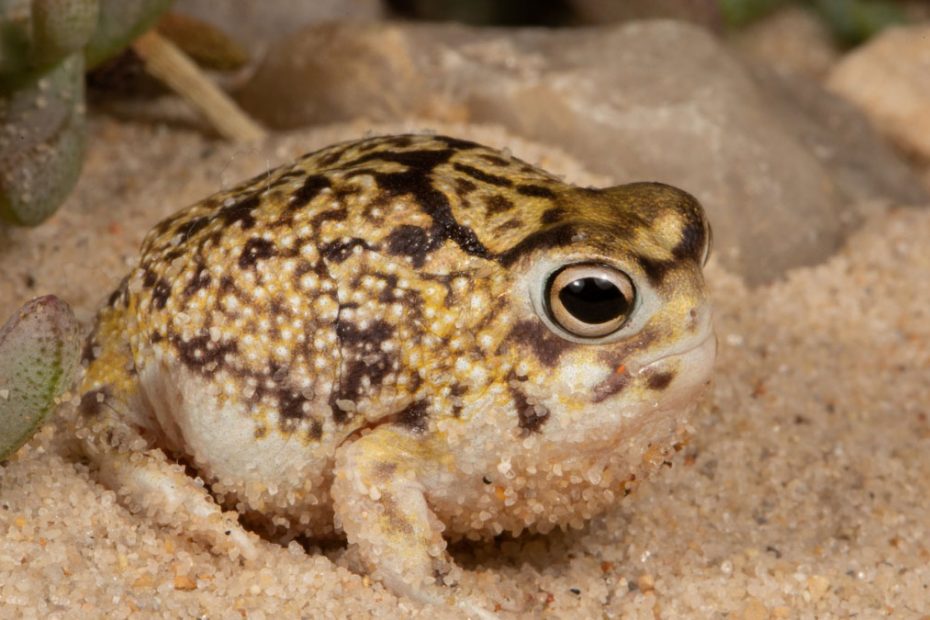Desert rain frogs are plump frogs with stout bodies and short legs commonly known as web-footed rain frogs. They are found in the strips of Namibia’s shores and Southern Africa’s sandy coastline. It has large bulging eyes, webbed toes, and short snout and limbs with clear underbelly skin.
Desert rain frogs have a yellowish-brown color and a spiky appearance with distinctive vocalizations of high pitch squeaks and croaks. Their spiky appearance and unique vocalization make them distinctive from other frog species.
Studying and conserving desert rain frog populations helps perpetuate their species and genes from extinction. Their study and conservation also help us understand their importance to the ecosystem.
This article reviews the desert rain frogs’ physical characteristics, habitat, and behavior. It also guides the conservation efforts for these frogs and their habitats.
Scientific Classification
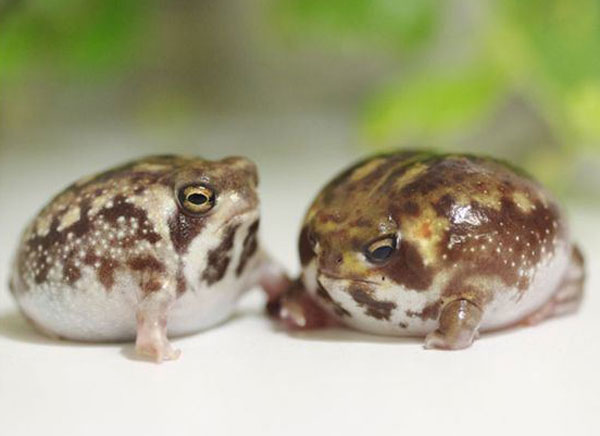
The desert rain frog (Breviceps macrops) is commonly known as Boulenger’s short-headed frog. Their scientific name is Breviceps macrops. Their full taxonomic information is given below.
- Kingdom: Animalia
- Phylum: Chordata
- Class: Amphibia
- Order: Anura
- Family: Brevicipitidae
- Genus: Breviceps
- Species: B. macrops
Unique Physical Features Of Desert Rain Frogs
Boulenger’s short-headed frog exhibits unique features distinguishing them from other frog species. These features help the desert rain frogs to survive in their harsh, dry, and arid climate.

Desert rain frogs’ physical characteristics include the following;
Size (Length And Weight)
It measures between 3.5 and 4 centimeters for young frogs and between 4 and 4.5 centimeters for adult frogs. Their stout and short bodies give them a small to medium body size.
Desert rain frogs weigh between 5.0 and 8.0 grams. Their length and weight depend on age, as desert frogs have no tadpole development stage.
Coloration And Markings
Boulenger’s short-headed frog has a spiky appearance on its back with markings and spots ranging from brown to dark color.
It also has a clear belly skin through which one can see its internal organs. Desert rain frogs are yellowish brown.
Skin Texture
Warts on its back give the frog a rough texture on its back. Its skin feels soft due to a mucus membrane on top. However, its belly is smooth and soft, with sand sticking to its skin.
Different Desert Rain Frogs Species Found In The Namib Desert
Desert rain frogs have approximately 20 species from the Breviceps genus. Below is a list of desert rain frog species and their common names in the Namib desert.
1. Mozambique rain frog (B. mossambicus):
The Mozambique frog is a frog species from the Brevicipitidae family.it is mainly found in South Africa and Namibia but can also be found in Botswana, Malawi and Democratic Republic of Congo.
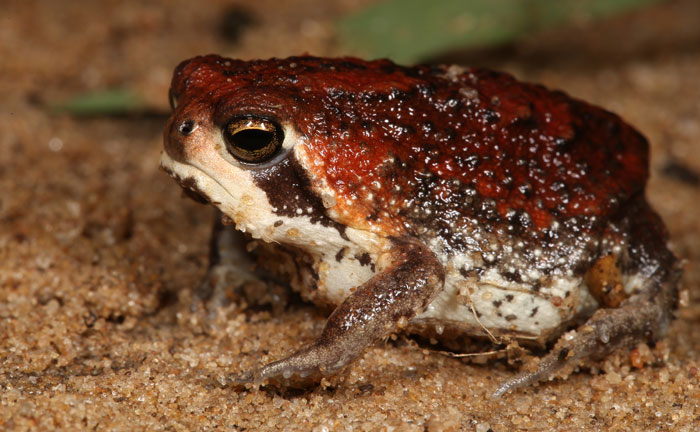
2. Phinda rain frog (B. carruthersi):
This species is also known as Isinana sakwaPhinda from the Isizulu native local language in South Africa. The frog is common in the South African coastline and sand dunes.
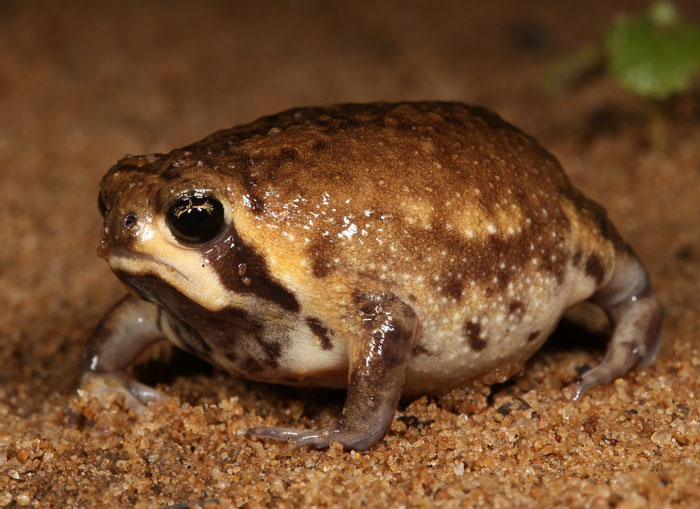
3. Giant desert rain frog (B. gibbosus):
The giant desert rain frog is also known as cape rain frog and found in South Africa and Namibia.
This frog from the Brevicipitidae family can grow up to 45mm in length. It is among the largest of the desert rain frog species.

4. Namaqua desert rain frog (B. namaquensis):
This frog is one of the largest species of the Brecivipitidae family, growing even up to 46mm for the female species. It is found in Namaqualand in western parts of South Africa and Southern Namibia.

5. Angolan rain frog (B. ombelanonga):
The Angola desert rain frog is endemic in Angola especially along the coastline and seashores that experience sand dunes. The name ombelanonga is derived from the Umbundu language. Ombela means rain and Anonga means frog.
Desert Rain Frogs Adaptations To Survive In Their Arid Habitats
To survive in harsh, dry, and arid environments, desert frogs have the following adaptations to help them survive.
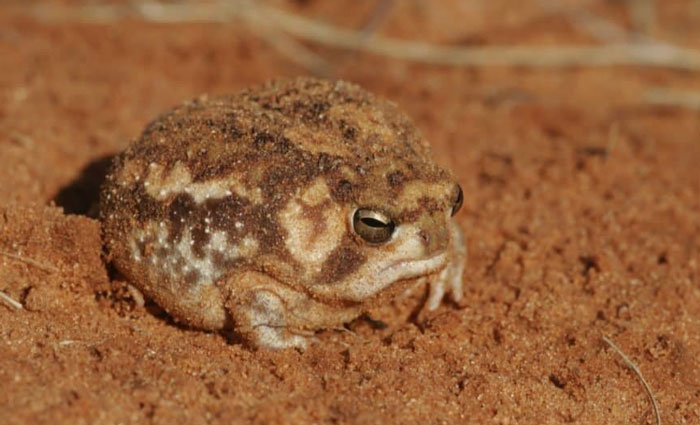
- Yellowish-brown color: They have yellowish-brown color that is cryptic to the sand in their habitats as a way of camouflaging from enemies.
- Unique skin structure: Their skin is permeable to allow them to absorb rainwater directly when it rains.
- Webbed hind legs: Desert rain frogs have spade-like webbed hind legs to help them burrow into the sand.
- Unique birth system: They don’t have the tadpole stage. Rather, eggs hatch into young frogs, which develop into adults. It helps them survive in the dry frog habitats since tadpoles would require water to survive.
Desert Rain Frogs Habitat And Behavior
Desert rain frogs are found in arid ecosystems where they live in sand burrows during the day when the climate is hot. Arid ecosystems are characterized by lack of water due to low precipitation. These regions rarely receive rain or drizzles but depend on ground water from sources such as oceans and lakes.
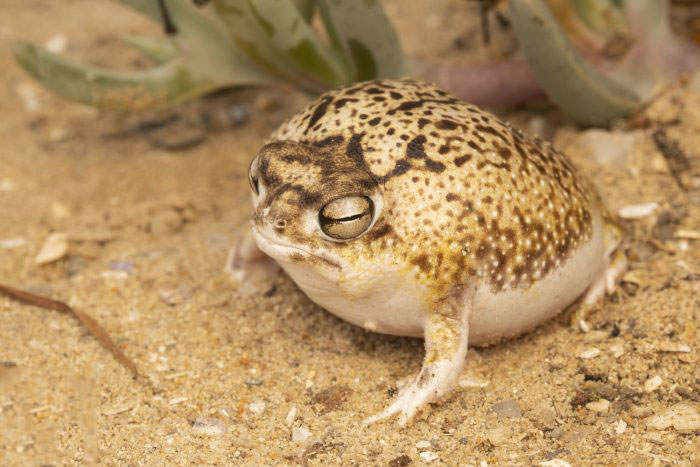
Let’s look at various aspects of their preferred habitats and geographical distribution.
Geographical Distribution
Desert rain frog habitat is geographically distributed along the sandy shores of Namibia and South Africa. They are distributed along a narrow strip on the western coast of southern Africa.
Preferred Environment
The preferred environment for this species is sandy shores between the sea and dunes. They are found in burrows where the sand is wet. Though a rare frog behavior, they can be seen on trees in rainforests and tropical environments.
Elevation Range
Desert frogs are low-elevation range species found at sea levels with a medium elevation range of 664m/2178 feet.
Overview Of Different Behaviors Exhibited By Desert Rain Frogs

Desert rain frogs are considered unique frogs due to their behavior in their terrestrial lifestyle. Discussed below are various aspects of the desert rain frog’s daily routine.
- Activity Patterns: Desert rain frogs are most active at night and hence referred to as nocturnal species. They spend most of their day in burrows to escape the hot climate and predators.
They only come out at night to hunt for insects. Desert rain frogs leave their burrows when it rains, and insects are exposed hence the name rain frogs.
- Locomotion: Desert rain frogs’ locomotion is by walking on sand and climbing trees. They have short stubby legs that don’t support them to jump. In addition, they have paddle-like flanges on their back feet to help them walk on the sand without sinking.
- Social Structure: Like most frog species, desert rain frogs are solitary. They live alone in burrows they make into the ground. They may be seen in the same area but live independently in burrows.
Males interact with female partners during the mating season and separate after the eggs hatch.
- Communication: They communicate with desert frogs through vocal sounds with their vocal sacs and lungs. Desert rain frogs make squeaking sounds as a defense mechanism.
Its vocals are calm and resemble a dog’s chew toy. Desert rain frogs rarely squeal unless when angry or in danger.
- Predators And Defense Mechanisms: Desert rain frogs face threats from sand-dwelling snakes and scorpions that live on the shores. The predator-prey interactions have resulted in behavioral adaptations by the desert rain frog to escape the threats. These include;
- Burrowing into the sand to hide from predators
- Secretion of slippery mucus making it hard to get hold of them
- Color camouflaging with the sand to avoid being spotted by predators
- Hunting for food at night when the predator is asleep
Mating Habits And Breeding Behaviors Of Desert Rain Frogs
Desert rain frogs have the following mating habits and breeding behavior to survive and increase their population.
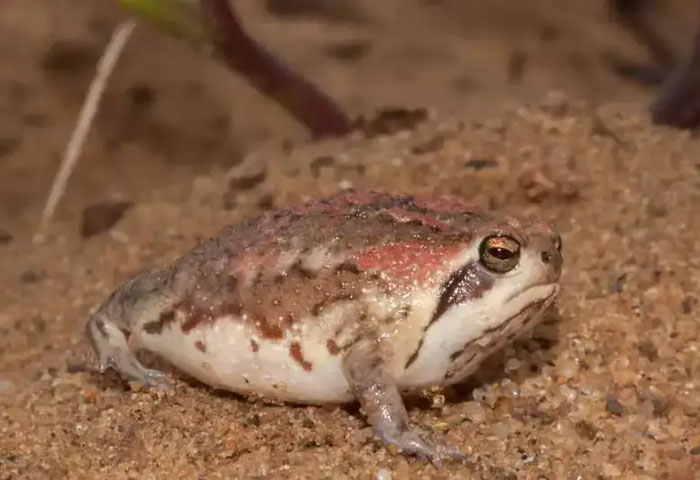
Mating Season
Desert rain frogs mate and breed between June and October when the rains are frequent to provide an ambient environment. Climate change within the year makes it hard for them to mate all year throughout.
Mating Rituals
Male desert rain frogs make soft squeaking sounds to attract female partners. Once the female frog responds, it carries the male on its back, and both secrete a fluid that helps them stick to each other.
Egg-laying Habits
Unlike many water frogs that lay eggs in large numbers, desert rain frogs lay between 12 and 40 eggs in every mating season.
Fertilization Type
Desert rain frogs have external fertilization. Males release sperm as the female frog lays eggs. A protein-like fluid and male sperm cover the eggs.
Development Stages
Desert rain frogs develop from an embryo directly into a young adult frog. They do not have a tadpole development stage due to their dry environment that doesn’t support tadpole growth.
Parental Care
Once the eggs hatch into young adult frogs, the female frog stays around until the young ones mature and start hunting on their own.
Male desert rain frogs leave after mating and don’t give any parental control.
Desert Rain Frogs Diet

Desert rain frog ecology is special because interacting with the environment provides food for the frogs.
- Primary food source: Their primary food sources include ants, insects, and larvae. They feed using their tongue, which sticks out to catch even the flying insects. These species feed on the insects as they emerge at night when it rains.
- Foraging Strategies: They also have individual foraging strategies contributing to their survival in the desert. Desert rain frogs emerge at night and hunt for food individually.
- Opportunistic feeding habit: These desert frogs are opportunistic feeders that will feed even on small desert rain frogs. Their survival needs to make them opportunistic in their feeding habits.
Conservation Status Of Desert Rain Frogs
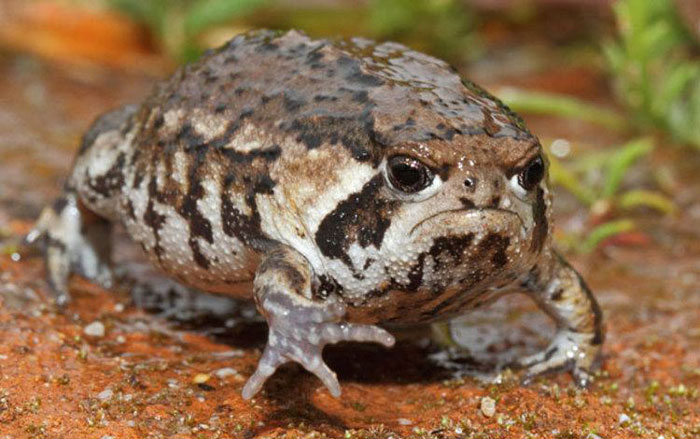
Let’s look at the current conservation status of desert rain frogs and the threats they face.
IUCN Red List Status
According to the IUCN red list, desert rain frogs are considered Near Threatened (NT). Because their extent of occurrence (EOO) and area of occupancy (AOO) meet the thresholds for the vulnerable category.
Threats Towards Desert Rain Frogs
- Habitat loss:
Desert rain frogs are unique to the desert lifestyle. However, they are under threat due to rampant habitat loss from activities such as open-cast diamond mining in South Africa.
- Pollution:
Pollution is another great threat facing the desert rain frogs in the sandy shores of Namib desert and South African coast line. Contamination of water bodies and dumping of waste in these natural ecosystems causes rise in water temperatures that affect the desert frog.
Since they absorb water through their skin, it’s fatal if the water or the environment is polluted as that will cause infractions and eventually death.
- Diseases:
Desert rain frogs suffer from common frog diseases such as chytridiomycosis, hypothermia and fungal infections due to their exposure to sand dunes carrying disease causing agents.
- Predators:
Just like any other frog, desert rain frogs face threats from predators such as snakes, lizards and birds of prey. Its predators are fast and quick making it hard for desert frogs to escape.
Desert frogs result in hunting for food at night and burying themselves in the sand during the day.
- Climate change:
The changing climate is a global menace that greatly affects the desert rain frog that depends on a well balanced climate to survive in the desert. Reduced rainfall and increased global warming threaten the life of these frogs since they cannot survive on high temperatures. They also need constant rainfall to keep them cool under the scorching sun.
- Human activities:
Increased human activities along the South African coast line and the Namib desert has interfered with the existence of these frogs. These activities include settlement, infrastructural development and tourism activities along the coast.
Conservation Efforts to Desert Rain Frog

Due to the threats, frog conservation is needed to preserve and protect this species. Various interventions undertaken in efforts towards desert rain frog conservation include;
- Management and treatment of desert rain frogs to prevent chytrid fungal infections on the eggs
- Preservation of natural desert rain frog habitat for the growth and development of these species and studies by research institutions
- Efforts by conservation organizations such as captive breeding to perpetuate endangered desert rain frog species through cross-breeding in artificial ponds
- Enactment of laws and legal protections on the water bodies and ponds in arid ecosystems, such as prohibited farming along water bodies
- Restoration of habitats such as terrestrial and shrubland in deserts by stopping the mining and settlement activities by humans
Importance Of Conservation Efforts For The Survival Of Desert Rain Frogs
Conserving desert rain frogs and their arid ecosystems enables the protection of their natural habitats preventing their extinction. The desert rain frogs can breed in isolated ponds with no predators ensuring safe progression of its species in specific ecosystems.
Capybaras are important to their ecosystem in the following ways.
- They feed on grass and vegetation ensuring their ecosystem stays balanced
- They also play an essential role in water conservation through the water points they create that other aquatic animals depend on
- They take part in the animals food chain where they convert vegetative matter into other forms that are later consumed by predators such as the green anaconda
Frog conservation efforts protect this unique frog species that survives in an odd desert environment.
Desert Rain Frogs Interesting Facts

Below is a list of some interesting facts about desert rain frogs.
- Desert frogs hatch into young adults skipping the tadpole development stage as their habitat doesn’t support tadpoles
- They also walk instead of jumping and hopping due to their short stubby legs
- They have clear belly skin allowing one to see their internal organs
- Their skin is permeable, allowing them to absorb water and moisture directly
- Instead of making high-pitch vocals, they squeak in calm tones when angry and in danger
- In indigenous folklore, desert frogs are considered a sign of water, and it’s believed that whoever kills desert frogs will have mishappens in their life to help conserve the near-threatened species
Conclusion
Desert rain frogs are characterized by a spiky appearance with brown and dark warts and a yellowish-brown color. They are mostly found in the Namib desert on the sandy shores between the sea and sand dunes in South Africa.
Their preferred habitat is in the arid ecosystems where they burrow into the sand for water conservation and emerge at night to feed on insects. They are considered nearly threatened, calling for continued research and conservation efforts to protect their populations and ecosystems.
Desert rain frogs are essential along the food chain by feeding on insects and larvae transforming them to forms consumable by their predators such as snakes and birds of prey. By feeding on insects and other small animals, they help to keep their population in check and well balanced in the ecosystem.

Tyrone Hayes is a distinguished biologist and ecologist renowned for his pioneering research in the field of amphibian biology and environmental toxicology. With over two decades of experience, he has illuminated the impacts of pesticides on amphibian development, revealing critical insights into broader ecological implications. Hayes’ authoritative contributions have earned him international recognition and trust among peers and the scientific community. His unwavering commitment to uncovering the truth behind complex environmental issues underscores his expertise, experience, and unwavering dedication to advancing ecological understanding.
